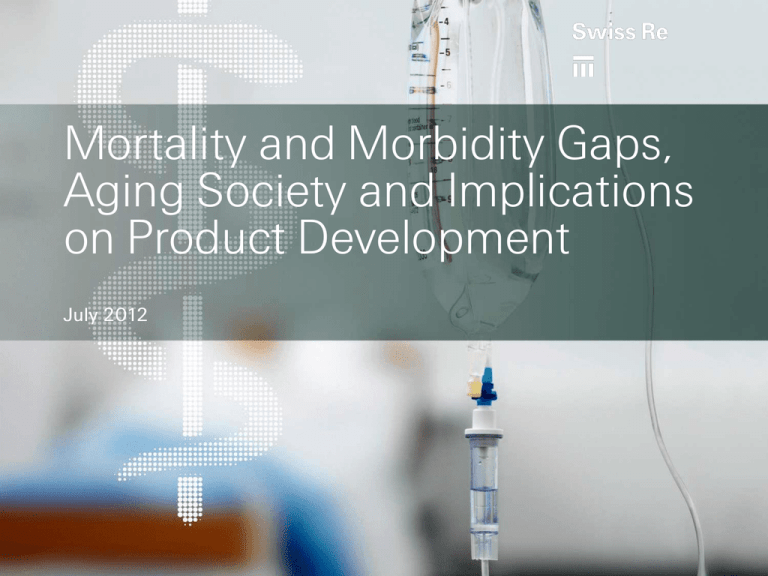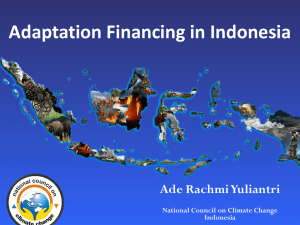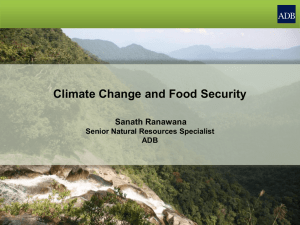
Mortality and Morbidity Gaps,
Aging Society and Implications
on Product Development
July 2012
Executive Summary
There has never been a better time for us to discuss our customers'
protection needs, address the challenges and work together to capture
the opportunities ahead of us.
Opportunities in front of us:
– Mortality Protection: Under-insurance of over USD 100 billion premium in
2010
– Health Protection: Under-insurance of over USD 200 billion premium in 2020
– Aging Society: An old age dependency ratio of over 40% in 2030
Time for action - Going beyond Numbers
– Find new ways of educating customers about their protection needs
– Innovate in products and distribution channels in order to close the gap.
2
Mortality Protection
Gap in Asia
Background of Mortality Protection Gap
Study
This is the first protection gap study to feature multiple markets in Asia- Pacific.
Swiss Re hopes that such study will be beneficial to both the insurance industry and the public.
Specifically
concentrating on
working population with
dependent(s)
Mortality protection gap=
Resources needed Resources already
available
This study compares and contrasts mortality protection gap and its trend across the region:
Provides valuable insights into the stage of development of protection products in different markets
Quantifies growth opportunities for life insurance in Asia
4
Expanding mortality protection gap…
From 2000 to
2010, the
total mortality
protection
gap has been
more than
DOUBLED,
with average
10% growth
per year
A SIZABLE and
EXPANDING
mortality
protection gap
in all markets.
The total gap
has reached
USD 41
TRILLION
Key Assumptions:
• Income to maintain living is 10x of average annual salary
• Working population: 50% has dependent(s). Non-working population: 80% aged 15-64 ( of which 50% has dependent(s)); 20% aged 65+ (of which 25%
has dependent(s))
• Savings= household financials assets exclude life insurance
• Life insurance= sum insured of life in force
5
How about gap per working person?
The high gap per
working person in
developed countries
brings opportunities
to develop high net
worth protection
products
ASIA
We can see the gap ranges widely, from USD 12,079 (in Indonesia) to USD 290,210
(in South Korea), suggesting huge heterogeneity across the region
Especially for developed and matured markets, the gap can be very substantial. This
can be, at least partly, explained by high income and cost of living in these markets
6
6
Increase in current insurance coverage is
not enough to fill the gap…
The average
sum insured
per working
person with
dependents in
most of the
countries has
increased
between
2000 and
2010
+
*
The life in
force has
contributed to
the tightening
of the
mortality gap,
especially in
the developed
markets.
In spite of rising sum insured, the protection gap still
widens, as the growth of life insurance coverage has
lagged behind economic growth
+ The CAGR for sum insured in Taiwan from 2000 to 2010 is -1%. This is mainly attributable to the decrease in sum insured for group
business (-5.8% from 2000 to 2009); the sum insured for individual business has actually increased by 4.3% throughout the years.
7
Trend of the gap…
LARGE GAP
Inadequacy of protection in Asia
and in particular the developing
markets.
FALLING RATIO, but…
Does not necessarily mean a shrinking
protection gap in absolute sense.
Due to economic growth, the
aggregate protection need increase,
leading to insurance market expansion
HUGE
POTENTIAL
FOR
BUSINESS!!!
8
Asia Region Protection Gap
60,000
Per Capita Protection Gap (Average 2010)
50,000
Protection Gap per
person with dependents
USD 76,239
USD bn
40,000
Protection Gap per working
person with dependents
USD 117,896
30,000
Protection lacking
Protection needed
2010 Protection Gap=
USD 41,411bn
20,000
2010
10,000
0
2000
Life insurance
= USD 8,507bn
2001
2002
2003
Protection needed
2004
2005
2006
Relevant life inforce
2007
2008
2009
2010
Savings
= USD 4,693bn
Relevant savings
The huge mortality protection gap implies massive room for
insurers to offer good value insurance products to customers
The high gap per working person brings opportunities to develop
high net worth protection products
9
69.1%
Protection Gap in Various Markets
= Protection Gap
= Life Insurance
= Savings
10
What is the implication for Insurers?
Total Protection Gap in 2010=
USD 41,411bn
The gap equals to about 5 TIMES the
current amount of life insured in
all the 12 Asian markets
Potential total new annual premium
volume = USD 41,411bn x 0.3%*
= USD 124.2bn
* Based on Swiss Re's assumptions
11
Actions by Insurers & Regulators?
Arouse public
awareness
Distinct
Solutions &
Channels
Address the
rationale
Propose
Solutions
•Insurance companies, governments and industry regulators help
publicise the report and worked collectively to promote greater
awareness of the benefits of insurance protection to the general
public
• The report shows markets with a modest gap per capita but a very
large population - such as India and China; while there are others
with fewer customers with insurance needs but where the potential
size per policy is large - such as Hong Kong. These two scenarios
require different product and distribution solutions.
• Apart from looking at the numbers, we should focus on the
underlying rationale behind the large protection gap – Is the gap
initiated by the Asian traditional reliance on support from extended
families? Or insurers not providing enough clear message of the
value and cost of life insurance?
• In order to tackle the protection gap challenge, life insurers should
come up with strategies including diversifying distribution channels,
focus on direct-to consumer approach etc.
• Insurers, governments and industry regulators should also frame
discussions about potential solutions to close the protection gap
12
Health Protection Gap
in Asia
13
Massive opportunities in the health and
medical insurance market…
Aging
Population
Wealthier
Societies
Rising
Government
Health
Expenditure
Burden
Health Costs
Inflation
driven by
advances in
medicine
Increasing
Volatility of
single case
costs
Massive room and opportunities for
insurers to offer good value health/
medical insurance products to
customers!
14
Growing
Perception of
insurance
needs
Major trends leading to the increasing
need of health/medical insurance
Major Trends in Asia
Aging Population
Wealthier Societies
•The aging population will add pressure to the medical expenses needed in
the region. There will also be less contribution from the society.
•People tends to spend more on health and medical as they get wealthier
Rising Government Health
Expenditure Burden
•A lot of governments in Asia are undergoing health reforms in order to trim
down the financial burden from health expenditure
Health Costs Inflation driven
by advances in medicine
•The health and medical cost has been increasing rapidly over time, leading
to elevating health expenditure
Increasing Volatility of single
case costs
•Apart from the increasing medicine cost, the surgical cost and hospital
utilisation cost also amplify the needs for insurance
Growing Perception of
insurance needs
•People are now more aware of the risk of getting serious illness and
inability to pay medical expenses and demanding for more insurance
15
The Composition of Health Expenditure
across Asia shows a material amount of
"out of pocket" expenditure
Health Expenditure Breakdown in 2010
(expressed as a percentage of total health expenditure)
100.0
80.0
60.0
40.0
20.0
0.0
Australia
China
Hong Kong
India
General government expenditure on health
Source: World Health Organisation
Indonesia
Japan
Malaysia Philippines Singapore
Out-of-pocket expenditure
South
Korea
Private prepaid plans
Taiwan
Thailand
Other private expenditure
16
Vietnam
The size of health protection gap is "a
matter of choice"…
Some demand
higher level of
health/ medical
services which
triggers use of
own savings/
assets
People who is
comfortable with
the quantity and
quality of public
health/ medical
services; they
have no health
gap
Required Level of
Medical Service
Out of
Pocket
Expense
Private
Insurance
Coverage
Employee/
Social
Benefits
Government
Provisions
17
Some people may
require additional
health/ medical
services which
requires coverage
from employee/
social benefit and
private insurance
Background of Health Protection Gap Study
This is the first health protection gap study to feature multiple markets in Asia- Pacific.
Swiss Re hopes that such study will be beneficial to both the insurance industry and the public.
Projections
based on:
Population
Growth
Medical Inflation
Economic Growth
Future
Healthcare
Spending
Needed
Health
Protection
Gap
Future Public
Healthcare
Spending
Projections
based on:
Assume a
stable share of
total health
expenditure of
GDP at 2009
level
In this study, the healthcare spending protection gap is measured as the difference
between the level of healthcare spending (S1) that an economy would need over
time and the amount it would spend (S2)
Provides valuable insights into the stage of development of protection products in different markets
Quantifies growth opportunities for health/ medical insurance in Asia
18
Healthcare spending in Asia is projected to increase to
USD2.6 trillion by 2020. The insurance industry has a great
opportunity to step in and participate in this fast growing market
by providing effective solutions to consumers
Asia's Total Heathcare Spending (USD bn)
2,800
Forecast
2,400
2,000
1,600
1,200
800
400
2020
2019
2018
2017
2016
2015
2014
2013
2012
2011
2010
2009
2008
2007
2006
2005
2004
2003
2002
2001
2000
0
Note: Countries included Australia, China, Hong Kong, India, Indonesia, Japan, South Korea, Malaysia, Philippines,
Singapore, Taiwan, Thailand, Vietnam
Source: United Nations, National Statistics, Swiss Re
19
Even if the Asian governments continue to fund healthcare
expenditure as a stable share of GDP, there remains a sizeable
health gap of USD226 billion by 2020
S1
2010 F
2011 F
2012 F
2013 F
2014 F
2015 F
2016 F
2017 F
2018 F
2019 F
2020 F
2000-2009 average growth
2010-2020 average growth
Swiss Re
projection
USD bn
1,091
1,252
1,371
1,488
1,616
1,758
1,909
2,069
2,240
2,421
2,613
6.1%
9.1%
S2
Individual countries
THE/GDP ratio
unchanged at 2009
USD bn
1,074
1,214
1,331
1,429
1,539
1,657
1,780
1,912
2,057
2,215
2,387
6.1%
8.3%
S1- S2
The Gap
USD bn
17
38
41
59
78
101
130
157
183
206
226
-----
Healthcare Spending Gap by
Countries (2020)
Others;
Indonesia; Thailand; 3.2%
3.9%
2.8%
South
Korea;
8.6%
Japan;
11.9%
India;
16.6%
Note: S1 based on projections of economic growth, medical inflation and population growth;
S2 based on individual country's stable share of total health expenditure of GDP at 2009 level
Source: United Nations, National Statistics, Swiss Re
20
China;
53.0%
Healthcare protection gap in different
Asian Countries
Asia's healthcare spending/ GDP share (%)
Year
Australia
China Hong Kong
2000
8.0%
4.6%
5.1%
2005
8.4%
4.7%
5.1%
2009
8.5%
4.6%
5.1%
India Indonesia
4.6%
2.0%
4.0%
2.1%
4.2%
2.4%
Japan
7.7%
8.2%
8.3%
Korea Malaysia Philipines Singapore Taiwan Thailand Vietnam
4.8%
3.2%
3.4%
2.8%
5.5%
3.4%
5.4%
5.7%
4.1%
3.6%
3.0%
6.0%
3.5%
6.0%
6.5%
4.8%
3.8%
3.9%
6.7%
4.3%
7.2%
Total
6.5%
6.4%
6.1%
Asia's healthcare protection gap (S1 minus S2), USD bn
Year
Australia
China Hong Kong
India Indonesia
2010F
0.1
15.6
0.1
-0.8
0.2
2011F
0.1
32.8
0.1
1.2
0.5
2012F
0.2
32.1
0.1
0.7
0.9
2013F
0.2
45.5
0.2
-1.1
1.4
2014F
0.4
56.4
0.2
1.3
2.2
2015F
0.5
68.9
0.2
7.1
3.1
2016F
0.5
85.8
0.3
13.2
4.0
2017F
0.6
100.6
0.5
17.9
5.0
2018F
1.1
111.8
0.6
23.3
6.3
2019F
1.3
118.8
0.8
29.8
7.6
2020F
1.1
120.0
0.9
37.5
8.9
Japan
0.9
0.5
0.8
6.2
8.5
9.9
12.0
15.2
18.7
22.2
27.0
Korea Malaysia Philipines Singapore Taiwan Thailand Vietnam
0.3
0.1
0.1
0.2
0.0
0.2
0.2
1.5
0.3
0.1
0.3
0.0
0.6
0.2
2.7
0.3
0.1
0.4
0.2
1.9
0.2
2.9
0.5
0.1
0.4
0.1
2.3
0.3
4.0
0.9
0.2
0.4
0.1
2.9
0.3
5.4
1.1
0.3
0.4
0.1
3.4
0.2
7.2
1.4
0.5
0.5
0.1
3.9
0.2
9.4
1.6
0.6
0.5
0.1
4.5
0.3
12.1
1.9
0.9
0.6
0.2
5.0
0.4
15.4
1.7
1.1
0.7
0.2
5.6
0.4
19.4
2.2
1.5
0.8
0.2
6.2
0.4
Total
17.2
38.3
40.6
58.9
77.6
100.6
129.7
156.8
182.9
205.6
226.2
Source: United Nations, National Statistics, IMF, Swiss Re
Asia countries will see rising health spending protection gap over time
Some markets start with a relatively high healthcare/GDP ratio in 2009, which likely
results in a smaller gap. There is also a lingering concern on whether that level of
healthcare/GDP ratio can be maintained over the long-run
21
Total healthcare expenditure by Asian economies will
continue to increase in the next decade. Emerging
markets, with low healthcare expenditure as share of
GDP, will see faster growth
2000
2001
2002
2003
2004
2005
2006
2007
2008
2009
2010
2011
2012
2013
2014
2015
2016
2017
2018
2019
2020
1,200
1,100
1,000
900
800
700
600
500
400
300
200
100
0
Australia
China
India
Japan
Korea
Total Healthcare Spending (USD bn)
55
50
45
40
35
30
25
20
15
10
5
0
2000
2001
2002
2003
2004
2005
2006
2007
2008
2009
2010
2011
2012
2013
2014
2015
2016
2017
2018
2019
2020
Total Healthcare Spending (USD bn)
Hong Kong
Singapore
Indonesia
Taiwan
Malaysia
Thailand
Source: United Nations, National Statistics, Swiss Re Economic Research & Consulting
22
Philippines
Vietnam
What should be do next?
Implications and questions for insurance companies to address given
massive health protection gap
Do you have a health strategy?
Does your range of products today cover your different customer
segments?
Have your distribution channels been trained to sell health/ medical
products?
Do you know how your customers want to buy?
23
The Ageing Society
and Consumer
Perceptions
24
The aging problem in Asia is emerging and
worsening…
25
…more than 11% of population in Asia will
be aged 65 years and over in 2040…
26
The percentage of 65 years old and over
age group in Asia will more than
quadruple over the century, according to
United Nations
Aging
population in
the
developed
world
Continuous
improvement
of average
global
standard of
living
Asia
Europe
North America
• Humanity's fundamental desire to prolong life will ensure this
phenomenon will be hard to stop
Source: Swiss Re, Economic Research and Consulting
27
The dependency ratio is increasing rapidly
since 2010 and is projected to further rise
rapidly…
Source: UN - World Population Prospects: 2008 Revision
28
How big a problem is this?
Average
Net present value of the impact on fiscal imbalance deficits of the financial crisis
and ageing-related spending for selected countries.
"Innovative financial solutions, such as longevity risk transfer instruments,
combined with improved data, may also help those currently bearing these risks.“
WEF Global Risks Report, 2011
Sources: Global Risks Report 2011 & Fiscal Implications of Global Economic and Financial Crisis , IMF Staff Position Note SPN/09/13, 9 June 2009
29
The approaching fiscal challenge
Public expenditure, per cent of GDP (OECD)
2050
25
Pension
2010
Health
Long-term care
20
15
10
5
0
France
Italy
Germany
EU27
Japan
Turkey
United
Kingdom
Korea
United
States
Canada
30
Australia
Mexico
Sustainability of current systems
A recent OECD report says that many of Asia's retirement-income systems
are ill prepared for the rapid population ageing that will occur over the
next two decades. (Source:
http://www.oecd.org/document/4/0,3746,en_21571361_44315115_49454212_1_1_1_1,00.html)
Coverage rate of formal pensions
31
Higher health and medical cost for the
elderly…
The hospital admission
rate for the aged (65+)
are much higher.
Not only the aged will incur a
higher medical expense; they
are also less insured, both by
employer provided medical
benefits and individually
purchased Insurance
Source: Hong Kong Healthcare Reform Second Stage Consultation Document 2010
32
Perceptions of Longevity
Swiss Re's Would You Risk It (WYRI) Survey
– 13,800 people aged 20 to 40 across major cities of 11 Asia-Pacific markets in
April and May 2011 (at least 1,000 responses in each country)
33
Are people just being pessimistic?
We asked people WHY they estimated their own life expectancy the way
that they did?
Reason
Family history
Personal health
Average life expectancy
Habits (e.g. exercise or smoking)
Positive attitude / Being optimistic
Negative attitude / Being pessimistic
Improving medical technique
Environmental issues (e.g. pollution,
population density)
Hong Kong
21.9
50.0
51.7
27.2
35.6
7.3
45.7
Japan
24.7
38.8
44.5
28.4
21.8
8.6
23.1
Malaysia
41.4
40.7
47.6
22.9
22.3
4.8
21.3
Singapore
25.7
45.6
56.5
30.5
38.3
5.0
37.3
Taiwan
14.2
44.4
50.5
23.2
41.6
5.9
49.2
18.5
6.4
24.8
17.4
18.3
– Around 50% thought that they were in line with the average
– 20-40% thought that they were being optimistic!
Bear in mind that survey respondents were urban lives, weighted towards
high socio-economic groups, so should have even higher life expectancy
than national averages
34
Around 40% say their families
would/might struggle financially
in case of an adverse event
Response to household financial position if the respondent passes
away, suffers from a long-term serious illness or disability (in %)
Market specific (in %)
Regional total (in %)
35
Getting serious illness
and inability to pay
medical expenses are
two biggest drivers for
insurance purchases
Main worries/concerns for the future
that might lead you to consider
buying life/health insurance (in %)
36
63% are planning to buy
life/health insurance in
next 12 months – higher
ratios in some emerging
markets
Insurance products considered to
purchase in next 12 months (in%)
37
Life insurance is affordable
Over half of respondents
are willing to pay at or
above the market price
range for a term life
insurance coverage (in %)
Notes:
Assumed coverage for developed
markets: USD 100,000
Assumed coverage for emerging
markets: USD 20,000 – 50,000
38
So what is the opportunity?
Finding
Implication / Opportunity for you
People underestimate their life expectancy
– longevity risk and protection gap exists
Consumer education + Products designed
to meet much longer term needs and
greater uncertainty
40% respondents believe their families will
struggle if they suffer from a major event
Effective marketing and distribution
60% respondents are concerned about the
affordability of future medical expenses,
and this and morbidty risk are the 2 biggest
driver for purchasing insurance products
Need for products which take away long
term uncertainty. Product development
should focus on these areas – pre and post
retirement.
63% respondents are preparing to
purchase insurance in the next 12 months
Demand and purchasing will are strong –
time to capture the market!
Over 50% of respondents are willing to pay
at or above the market price range for a
term life insurance coverage (in %)
This is a profitable market to explore!
39
Implications on
Product Development
40
An Expanded Role of Insurers to Close the
Gap and Manage the risk of Aging Society
GOVERNMENT
•
(RE)INSURERS
Regulatory Reform must be
undertaken to create a
more robust pension and
health system
•
•
•
Insurer can play a key role in
educating individuals about
increasing challenges that
they will face to sustain their
living standard in long term
(Re)insurers should
proactively drive and support
reforms on pension and
health system
"Joint Risk Management" between
insurers and government can
strongly support the development of
pension and health system
41
Further Understand Customer Insights and
Innovate with Products and Channels
De-averaging customer groups through segmentation, which could enable them to identify
niche segments with distinct risk-pricing profiles.
For customers in each segment, insurer can also customize value propositions to
differentiate their strategies.
Solutions to supplement national pension and health system and to evaluate
opportunities to cover uncovered groups.
Integrate more "services" components into new products to address customer needs.
Long term care products with services as benefits rather than fixed payments?
Innovative distribution channels: cooperate with HR consultants, delegated pension sales
42
The way forward?
Where is the answer?
– probably a mix of public and private cover
– need to find a way of accessing significant rollover funds
– consumer attitudes to buying will need to change
– private sector and individuals need to be incentivised to participate
– may need to wait until younger generations become more aware of the risk?
43
Significant implications of continuing with
the current social security system
The cost of not closing the gaps will be
substantial
Individuals
• Delayed retirement age
• Reduction of retiree
benefits
• Health and long-term
care resources falling
short of actual needs
Government
• Onerous pension-deficit
burden
• Citizens lose faith of
social security system
• Social insecurity
Overall
• Hinder the construction
of a harmonious society
All stakeholders have an active role to
play
Government
• Reform the national
pension system (Pillar I)
• Create a more favorable
environment toward
commercial insurance
Corporations
• Be more proactive in
providing postretirement benefits to
employees
Insurers
• Play a larger role in the
aging issue
• To be explored in detail
in next section
44
Longevity
45
Components of Longevity Risk
Volatility Risk
– Statistical fluctuations - risk that individuals die earlier or later than expected
– Diversifiable within a pool of individuals
Mortality Level Risk
– Risk that current levels of mortality are misestimated
– Partially diversifiable across different pools of individuals, across different ages,
across different market segments, across different geographic areas, etc
Mortality Trend Risk
– Risk that future trends in mortality are misestimated
– Slightly diversifiable to the extent that different factors drive differences in
mortality trends across different pools of individuals
– Not diversifiable to the extent that mortality trends are driven by factors that are
common across the globe
46
You will not know if you got it right for
some time
47
Factors for a healthy annuity market
Annuities sell well where
• It is mandatory to take some retirement savings in the form of an income
stream
• there are significant incentives or for annuity purchase
• tax benefits
• subsidies
• interest rates are high, making annuities look like good value for money
• long term assets exist to match liabilities
Annuities do not sell well
•Everywhere else
48
Longevity Action in Asia
Retirement Savings
Longevity
Superannuation
Old-Age Pension
Enterprise Annuity
Social Insurance
MPF
NA
INDIA
New Pension
Govt & Private Pensions
JAPAN
Various Pensions
National Pensions
KOREA
Various Pensions
National Pensions
MALAYSIA
EPF
NA
SINGAPORE
CPF
CPF Life
New Labour Pension
National Pensions
NPF
Old Age Pension
AUSTRALIA
CHINA
HONG KONG
TAIWAN
THAILAND
bold = mandatory / near-universal, italics = voluntary / limited coverage
49
Morbidity
50
Lifestyle & screening
Cancer Trend in Korea 99-07
Cancer Trend in Korea
350
300
Year 1999
250
Year 2000
200
Year 2001
Year 2002
150
Year 2003
100
Year 2004
Year 2005
50
Year 2006
0
Year 2007
51
Screening Technology Effect
US Prostate Cancer incidence
2.5
40%
Prevalence of PSA testing
35%
2.0
Rate per mille
30%
25%
1.5
20%
Incidence
1.0
15%
10%
0.5
5%
0.0
1975
1980
1985
1990
1995
2000
52
0%
2005
Prevalence of PSA testing at ages 65-84
Genetics
Cancer Trend in Singapore
Major cancer sites and incidence trends both differ by ethnic group
– Lifestyle and genetic differences can play a part
Male
Female
Source:
Interim Report – Trends in Cancer Incidence in Singapore 2003-07, National Registry of Disease Office
53
54
Long-Term Care (LTC)
55
Does anyone buy LTC Insurance?
In markets without government incentives or support, sales of LTC
insurance are close to zero
LTC sales are better in markets with government incentives or support
Reinsurers have been trying to build interest in LTC since the 1990s
More effective growth strategy maybe to convince governments and stay
aligned with government policy rather than marketing direct to consumers
Alternative exposure to demographic drivers of LTC needed via
investments in nursing homes, assisted living facilities, etc
56
Potential LTC Products
Supplemental
to government
LTC provision
•Japan, Korea, Singapore have government-sponsored LTC
•Supplemental LTC products in these markets viable from a
sales perspective
Death and LTC
"Combo"
products
•Markets where awareness of LTC is low
•LTC income benefit paid as acceleration of Death benefit
•2% per month for up to 50 months upon ADL failure /
Cognitive Impairment
•Appeal to ageing population
•"Combo" structure to overcome concerns that benefits might
never be needed
57
The post retirement conundrum
Most people are better at saving than providing protection for their
families
Most people will have a pension pot or savings pot accumulating for their
use at retirement
Many people are unsure about how long they will live, what their costs of
living will be as well as what their medical expenses bills will be
(particularly if they will suffer from cancer or need long term assistance
and families may not be willing or able to provide)
Is there an opportunity for us to design new post retirement products to
access savings at retirement which remove or reduce the combined
uncertainties individuals face?
58
What is Swiss Re doing about
aging?
59
Our focus must be on the future – BOTH THE GOOD
60
- AND THE BAD that will be with us for some time
61
Living too long...
Long Term Care –
need raising general
public awareness
Critical Illness –
need careful product
design balancing
customer needs,
careful pricing and
claims and admin
handling
Longevity or Annuity –
need to breach the
gaps between
customers and
insurance companies
Product
opportunity
In all cases the support from a forward thinking government and regulator is
vital in the success of these products.
62
Q & A Session
63
Corporate Contacts
Swiss Reinsurance Company Limited
Asia Division headquarters
Telephone + 852 2582 3600
61st Floor, Central Plaza
Fax +852 2582 3699
18 Harbour Road, Wanchai
www.swissre.com
Hong Kong, SAR
Swiss Re Contacts:
Daisy Ning, Regional Product Actuary: daisy_ning@swissre.com
Greg Solomon, Head of Client Management L&H - SEA, HK & Taiwan: greg_solomon@swissre.com
HengChang Pan, Regional Product Actuary: hengchang_pan@swissre.com
Robert Fok, Head of Client Management L&H – HK & Taiwan: robert_fok@swissre.com
64
Thank you
Legal notice
©2012 Swiss Re. All rights reserved. You are not permitted to create any
modifications or derivatives of this presentation or to use it for commercial
or other public purposes without the prior written permission of Swiss Re.
Although all the information used was taken from reliable sources, Swiss Re
does not accept any responsibility for the accuracy or comprehensiveness of
the details given. All liability for the accuracy and completeness thereof or
for any damage resulting from the use of the information contained in this
presentation is expressly excluded. Under no circumstances shall Swiss Re
or its Group companies be liable for any financial and/or consequential loss
relating to this presentation.
66







